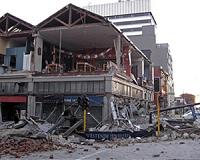| . |  |
. |
Seville, Spain (SPX) Dec 03, 2010 Researchers from the Universidad Pablo de Olavide (UPO) and the Universidad de Sevilla (US) have found patterns of behaviour that occur before an earthquake on the Iberian peninsula. The team used clustering techniques to forecast medium-large seismic movements when certain circumstances coincide. "Using mathematical techniques, we have found patterns when medium-large earthquakes happen, that is, earthquakes greater than 4.4 on the Richter scale," Francisco Martinez Alvarez, co-author of the study and a senior lecturer at the UPO revealed to SINC. The research, which will be published this month by the journal Expert Systems with Applications, is based on the data compiled by the Instituto Geografico Nacional on 4,017 earthquakes between 3 and 7 on the Richter scale that occurred on the Iberian Peninsula and in the surrounding waters between 1978 and 2007. The scientists applied clustering techniques to the data, which allowed them to find similarities between them and discover patterns that will help to forecast earthquakes. The team concentrated on the two seismogenic regions with the most data (The Alboran Sea and the Western Azores-Gibraltar fault region) analysing three attributes: the magnitude of the seismic movement, the time elapsed since the last earthquake and the change in a parameter called the b-value from one earthquake and the other. The b-value reflects the tectonics of the region under analysis. A high b-value means earthquakes are predominantly small in size and, therefore, the land has a low level of resistance. In contrast, a low value indicates that there are a relatively similar number of large and small seismic movements, which implies the land is more resistant.
Successful Forecast Probability Greater than 80% "After the calculations had been performed, providing the circumstances and sequences we have determined to be forerunners occur, we obtain a significant success probability". The technique summarises the forecasts in two factors: sensitivity (probability of an earthquake occurring after the patterns detected occur) and specificity (probability of an earthquake not occurring when no patterns have occurred). The results reflect a sensitivity of 90% and specificity of 82.56% for the Alboran Sea region and 79.31% and 90.38% respectively for the seismogenic region of the Western Azores-Gibraltar Fault. That is, there is a high probability of an earthquake in these regions immediately after the patterns discovered occur (high sensitivity) and, moreover, on most of such occasions, they only occur after the patterns discovered (high specificity). At present the team is analysing the same data using their own algorithms based on "association rules", other mathematical techniques used to discover common events or those which fulfil specific conditions within a set of events. "The results are promising, although I doubt we will ever be able to say that we are capable of forecasting an earthquake 100% accurately," Martinez Alvarez conceded. A. Morales-Esteban, F. Martinez-Alvarez , A. Troncoso , J.L. Justo y C. Rubio-Escudero. "Pattern recognition to forecast seismic time series". Expert Systems with Applications 37 (12): 8333?, diciembre de 2010. Doi: 10.1016/j.eswa.2010.05.050.
Share This Article With Planet Earth
Related Links Spanish Foundation for Science and Technology Tectonic Science and News
 Researchers Reveal Way In Which Possible Earthquakes Can Be Predicted
Researchers Reveal Way In Which Possible Earthquakes Can Be PredictedJerusalem, Israel (SPX) Dec 01, 2010 Researchers at the Hebrew University of Jerusalem who have been examining what happens in a "model earthquake" in their laboratory have discovered that basic assumptions about friction that have been accepted for hundreds of years are just wrong. Their findings provide a new means for replicating how earth ruptures develop and possibly enabling prediction of coming severe earthquakes. "The ... read more |
|
| The content herein, unless otherwise known to be public domain, are Copyright 1995-2010 - SpaceDaily. AFP and UPI Wire Stories are copyright Agence France-Presse and United Press International. ESA Portal Reports are copyright European Space Agency. All NASA sourced material is public domain. Additional copyrights may apply in whole or part to other bona fide parties. Advertising does not imply endorsement,agreement or approval of any opinions, statements or information provided by SpaceDaily on any Web page published or hosted by SpaceDaily. Privacy Statement |